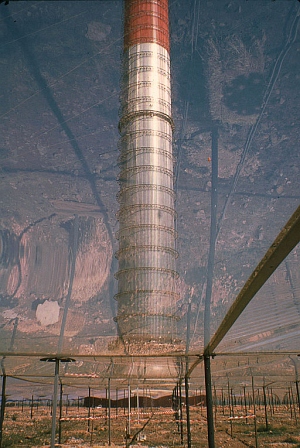Solar updraft towers for generating electric power were first conceived over a hundred years ago. Several prototypes have been developed over the decades, and some have been implemented and operated over the course of several years. These prototypes vary in size and scale, with the largest ones capable of producing tens of kilowatt of power with towers that are a couple of hundred meters tall (most notably, the solar updraft tower in Manzanares, Spain with a tower of 194 m tall and capable of producing 50 kW of electrical power).

Figure 10.4: Solar Chimney prototype at Manzanares, Spain. The tower is seen through the polyester roof.
The principle of operation of solar updraft towers is based on the stack effect: difference in the density of air due to temperature and humidity differences can drive air movement. Solar energy is used to increase the air temperature at the bottom of the tall chimney (tower), creating a gradient in density, which creates upward air movement. This solar-induced "wind" is used to rotate wind turbines installed in the confined space in the chimney. The power output of a solar updraft tower depends on two design variables - solar collector area and height of the tower. The collector is represented by a greenhouse-like structure at the surrounding ground at the base of the tower, and the commercial size collectors are designed up to 4-5 square miles in area. A greater height of the tower creates greater pressure gradient due to stack effect and results in more usable wind power. The known system heights are in the range 100-200 m, while systems as tall as 1500 m are being proposed (Wikipedia- Solar Updraft Tower).
There have been and continue to be many proposals for projects in countries around the world for solar updraft tower systems that are incredibly large compared to the scale that has been proven to date. The high capital cost remains the main barrier to commercialization and widespread use of this technology.
Supplemental reading:
Grouse, T.K., Solar Chimneys Can Convert Hot Air to Energy, But Is Funding a Mirage? National Geographic, April 16, 2014. URL: http://news.nationalgeographic.com/news/energy/2014/04/140416-solar-updr...
Zhou, X and Xu, Y., Solar Updraft Tower Power Generation, Solar Energy, 128, 95-125 (2016).
This paper presents a comprehensive technology review with some analysis of the performance, cost, and impacts.
